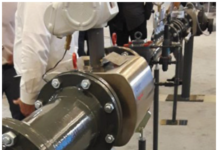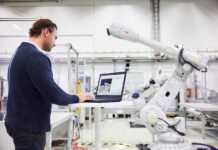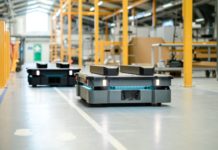During my recent interview with S?ren Nielsen, president of Mobile Industrial Robotics (MiR) I had the opportunity to discuss his vision for the company and the future of automated logistics in the manufacturing sector
Michael Majchrzak (MM):
As we near the end of the pandemic, can you tell us what you learned managing through the crisis and what did you learn about your customers?
S?ren Nielsen (SN):
One of the main issues during the pandemic was labor shortages as workers did not come to work for safety reasons. The labor shortage in manufacturing however is not due only to the pandemic but is part of a larger long-term trend. The long-term global trend is that the global work force is getting smaller and the work force that is there is demanding more and more interesting jobs. The number of people that will take these low education jobs will continue to shrink. Companies are compensating both for the short-term pandemic risk of labor shortages but are also reacting to the long-term systemic labor shortages by taking the least educated jobs out of the equation and automating them. We believe that our solutions can help adjust to this new reality.
MM:
Besides from labor shortages, how else was manufacturing and logistics affected by the pandemic?
SN:
The world?s global supply chains and the related logistical bottlenecks were interrupted. Because of Just-In-Time (JIT) inventory management and low stocks, if someone sneezes in India you feel it in the States. It is the new norm. The need to react to these challenges is getting bigger and bigger. One way to react is to simplify your supply chains and bring your production closer to you markets so that you gain more control of the whole process.
MM:
So, if companies start to manufacture their products locally it seems that there would be more and smaller factories around the world. Is that a good thing for factories and for your company?
SN:
Good question. The factories will still be larger, but not the Giga factories we hear so much about. Several hundred if not thousands of people. Companies that produced in countries like China, India, etc., will tend to move manufacturing closer their markets. Here we are talking about America and Europe. In Europe we are talking about Poland, Romania, etc. Just not China, Mexico or Brazil anymore.

MM:
Amazon has built four massive warehouses in Poland to serve this part of Europe. As the economy continues to move online and companies like Amazon proliferate with more and more giant warehouses needed for storage and delivery, where does MiR, with its generally manufacturing, and not logistics-based products, see its role?
SN:
If you look at where we are today, we are strongest in the manufacturing and especially in FMCG: automotive, plastics, metals, and other manufacturing sectors which have such companies as Nestle, Adidas, P&G, etc. But for companies like 3PL and other logistics warehouses, growth in mobile robotics is actually going to be much larger than manufacturing growth.
MiR?s key segment is so far not in the logistics sector. There are areas where our current robots can optimize processes, such as moving carts or waste materials. But we see a great need for AMRs being able to take pallets from off the ground and move them horizontally, and we are working on a solution just like that ? an autonomous pallet jack.
Especially in e-commerce, there?s a need to take things from shelves and place them at different elevations for example. We do not offer an out-of-box solution for this like other AMR companies, but it is possible to deploy robot arms on our mobile robots for a solution like this.
Due to our focus on manufacturing, it is a lot easier for us to install our systems and mobile robots in manufacturing companies than in warehouses because warehouses need much more time for integrating their mobile robot systems, whereas we can get up and running in about twenty minutes. We are still evaluating how to best introduce our products into the logistics space, and we will be able to offer specific solutions in time.
MM:
Speaking of integration, there is a lot of talk about ERP integration with logistics. We notice a convergence with ERP and design / PLM software for example for better resource management during the manufacturing process. To what degree are you integrating with ERP systems?
SN:
We do not want to be an integrator. We have partners that do integration.. Due to the fact that the variety of implementation is different every time, there are just too many variables for each project to justify doing the integration ourselves. What we do try to do for our integrators is to find ways to make the integration project easier for our customers. For example, if an ERP system wants to know if a task has been completed or not, the large amount of traffic of mobile robot fleets makes the task of accurately acquiring this information very difficult. We have developed an API for ERP so that set up and implementation for acquiring this information in an ERP system is much easier. Our goal is ease of integration, not integration itself.

MM:
You mention fleets of robots moving around factory floors and how challenging it is to manage that information. This leads to questions about safety. How safe are your products? Do you keep safety statistics?
SN:
We don?t have safety statistics because we have not had any major incidents. We?ve had robots that have come back to us damaged, so we know that there are accidents. We found that the biggest problem is forklift drivers not seeing our robots and colliding with our robots. People also walk in front of moving robots, however accidents due to malfunctioning or navigation mistakes of the robots are pretty much unheard of in our experience. Our robots do not report to us about accidents or give other sorts of safety feedback. We only have story telling back from our customers.
MM:
What is strategy with regards to working with cobots in order to create a sort of mobile Cobot? Is there demand for this type of configuration? It seems like it would be quite useful in warehousing and other applications, even manufacturing.
SN:
We are working with Universal Robots (UR) to fit cobots on some of our mobile robots. This project is in its infancy right now. For example, we are working with a T-1 supplier for using the MiR robot to pick things out of stores and put them on the MiR and drive them to a destination and deliver them. We also are working with an electronics manufacturer that wants to do machine tending. They want to automate it ? have a cobot on a mobile robot and move around to different machines for servicing the machines.
In fact, the market for cobots on mobile robots is expected to grow like crazy. I don?t know if we can believe the market intelligence, but there is massive growth in this area.
MM:
Besides the two applications you mentioned above, what are some of the other applications causing this massive increase in demand?
SN:
It is from many different things. We want to work with UR to meet this demand. However, a key question here is whether or not we will need to move into integration which as I mentioned earlier is something that we would rather not do. To combine these MiR and UR products you need to add a camera, a gripper, tools, height considerations, etc.
MM: So does that mean it is not part of your strategy to continue to develop these merged products?
SN:
It is currently not our strategy to make these products at this time because it goes against the strategy of both companies. But the market is demanding this. We basically must choose from between the three following strategies: 1) create standardized combinations of the products; 2) work with integrators to prepare the products for the combination / integration; 3) prepare our products so that we have a very simple ?plug and play? system for setting up the combination of MiR/UR so that any of our partners can create these products themselves. We have not decided yet which of three choices to make, however we are looking at all three options very closely.
MM:
It sounds like safety would be an even bigger issue with a combined MiR/UR robot due the degrees of movement increasing the complexity of the product.
SN:
We do ask ourselves ?Is it right to try and build this type of product or ask our customers to use it?? It is so complex that only a few customers will actually have the competencies to work with these products in a safe manner. These are some of things that we are considering, and I think that within the next year we will have a better understanding of what the market wants, and which strategy to take in order to implement it.
MM:
Talking about complexity, when I think about the programming required for a moving 5 or 6 axis Cobot riding on top of a mobile robot through space, I think that it might be too complex to program. How do you plan to deal with this issue?
SN:
The easy thing to do is to establish that the cobot and MiR robot are never moving at the same time. As you can imagine this could limit the functionality. As I mentioned, the combined product concept is still in its infancy and we are working on solutions. The real difficulty is the combined complexity of the safety zones.

MM:
I would like to talk about navigation. Tesla recently gave a presentation about its FSD (Full Self Driving) software. Elon Musk claims that the Tesla is producing the world?s largest and fastest robot with its cars. The amount of complexity that was presented using FSD was immense. They are basically trying to simulate and predict reality, which some people say is impossible. I know that MiR?s are not cars and you have a very controlled environment. Are you using or learning from any of the technology from self-driving like big data analysis and camera?s etc. that the automotive sector is using for FSD?
SN:
It is clear that modes of freedom are infinitely greater for cars. Using MiR?s, we can assume that certain rules are being obeyed and traffic rules are followed correct in our controlled environment. We look at this whole challenge in two ways: The first is ?Pre-5G? and the second is ?Post-5G?. Currently in Pre-5G we use Wi-Fi for communicating with the robot and the fleet. This is unstable and we have limited bandwidths, and there are problems when we move primarily because of handover problems between Wi-Fi access points. We can never allow control of a navigation system by software on the cloud or the edge cloud when we communicate via Wi-Fi. What we need to do in this case is to put all important decision-making software on the robot itself. The problem then becomes heating on the robot due to information processing, etc. We therefore are limited with how much processing we can put on the robot.
We also have equipment such as a camera that communicates with the fleet to avoid collisions for example. This all puts a burden on the robot during intense usage. To solve these problems, we are creating more self-driving technologies and even filing for patents on this technology and competing for patents with the likes of Google and Uber and other companies that are using FSD technology.
Then there is 5G. When we have 5G suddenly the world opens for us. With 5G we can have much more reliable communication between the robot and the fleet via the high bandwidths. With 5G we can use more AI without using more processing power on the robot. As soon as we know that 5G is being used at our customers? sites we can start increasing our own use of it in our products. We are following the development of 5G very closely. We are however faced with a dilemma: If we invest in the technology too early then we will be stuck with a lot of unused investments in our products, but if we are too late then our competition will do it first.
I think that we are probably 2 years away from adopting 5G. I know that some leading companies are doing it now, but so far only a few. We can only do it when our customers have installed networks in place.
MM:
The big debate now is whether LIDAR (Light Detection And Ranging) or cameras are better for navigation in FSD. Does this apply to MiR and which technology are you using?
SN:
We use both but for safety reasons we tend to use LIDAR the most. We have not found a way to use image processing fast enough to use on our robots and still maintain the high level of safety that is required and that from LIDAR. LIDAR can be used in deterministic ways for safety. But for just pure navigation we use cameras.
MM:
In the second Q of 2021 there was 6.5B USD invested globally in unicorn robot deals with over 177 deals being made with each deal on average worth around thirty-seven million dollars. How does all of this capital moving into robotics affect your business strategy? Are you investing, acquiring, or laying low?
SN:
We are aware of the fact that investments in terms of size and frequency in the robotics start-up sector are exploding or at least rapidly increasing. The market projections are big enough for many companies many times our size. We are trying to develop this market to the best of our abilities. We actually think that biggest competitor is ourselves. The transition from traditional technologies where we manually push or drag vehicles to move materials or have conveyors, those traditional technologies can all be converted into robotics systems. Therefore, the market potential is immense. And the ability to create that transformation happens by maturing our products and developing robust and stable solutions. We are past the point where robots are just funny machines. They are now automation systems; they need to run 24/7. We need service them so that customers can get back online as soon as possible during a pause in production. I think that the largest realization of the potential, which will happen gradually, but it will happen, is when the technology for robotics achieves industrial level. That means that it is the same level of quality and reliability of an industrial PLC and where we have the features and functions and services that allow companies to really depend on robotics 24/7. When we have that then the market potential will explode. We are working as fast and as hard as possible to get to that point. So, are we worried about competitors? No. Even if we thought someone was beating us at that race, the market is big enough for many more players. We just want to get there as fast as possible.
Thank you.





















































